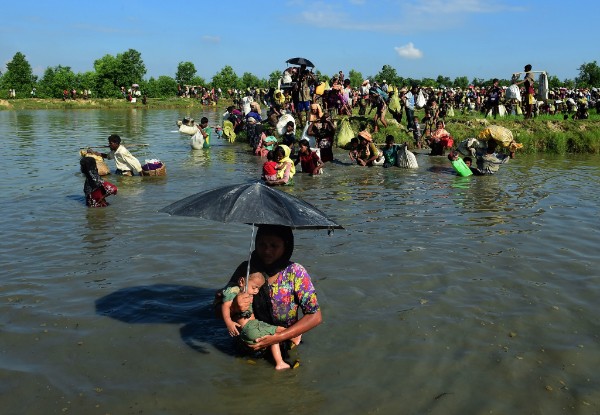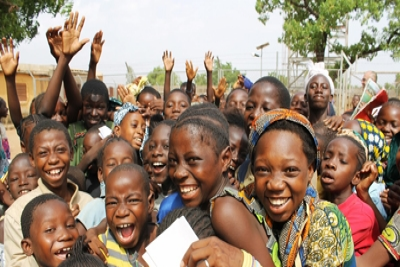| ||||||||||||||||||||||||||||||||||||||||||||
| ||||||||||||||||||||||||||||||||||||||||||||
| ||||||||||||||||||||||||||||||||||||||||||||
|
Friday, December 25, 2015
Thursday, December 24, 2015
In southern Bangladesh, the coastal town of Cox's Bazar is a well-known honeymoon destination. It is famous for its beach, one of the longest unbroken beaches in the world. But only 16 km from the beach, there is a different reality.



TOP: Rohingya refugees who fled from Myanmar wait to be let through by Bangladeshi border guards after crossing the border in Palang Khali, Bangladesh. 17 September 2017. Image credit: Mahmud Hossain Opu LEFT: Rohingya refugees at the Kutupalong-Balukhali extension camp, one of the largest refugee camps in the world, hosting about 600 000 people. Image credit: Mehak Sethi RIGHT: Children in the Kutupalong-Balukhali extension camp. Image credit: Mehak Sethi
Beginning of the crisis
25 August 2018 marks one year since hundreds of thousands of Rohingya people fled persecution and violence in Myanmar's Rakhine State and sought refuge in neighboring Bangladesh. This crisis stands out among recent refugee flows due to the large number of people fleeing in an extremely short period of time: about 655 000 Rohingya women, men and children fled to Bangladesh between 25 August 2017 and mid-December 2017, according to the United Nations. We have not seen a displacement of this level in decades.
The number of Rohingya in Bangladesh stands at about 890 000, according to the most recent situation report from the Inter Sector Coordination Group (as of 31 July). They live in approximately 34 camps in an area spanning about 26 square kilometers. Kutupalong and Balukhali mega camp, known as the Kutupalong-Balukhali extension camp, is one of the largest refugee camps in the world, hosting about 600 000 people. As well as being in one of the world's most densely populated areas, the area is prone to floods and cyclones.
For more information:

How we responded

New technology
The first case of diphtheria, a highly infectious disease, was reported in Cox's Bazar, Bangladesh in November 2017. The disease quickly spiraled to 150 suspected cases a day. Taming the outbreak has been a combined effort of international organizations, nongovernmental organizations and government agencies. One of their key tools has been WHO's Early Warning, Alert and Response System.

Vaccination campaigns
Dozens of immunization officers and field monitors have been working to provide mass vaccinations. This effort was mainly carried out by our Bangladeshi staff members, who have been at the heart of this response. To cover a huge immunization gap among the Rohingya population, more than 4 000 000 doses of vaccines have been delivered during 9 mass vaccination campaigns since September 2017.

Water testing and filters
In Cox's Bazar, water and sanitation continues to be far from optimal. This increases the risk of rapid spread of several communicable and water-borne diseases. Payden, the Regional Adviser for Water and Sanitation in WHO's South-East Asia Regional Office, worked intensively during her deployments to Cox's Bazar, testing water in households and working to get the right water filters for the community.

Logistics
WHO's logisticians are the backbone of every emergency response, including the Rohingya crisis. Since September, they have overseen the supply of more than 160 metric tons of essential medical supplies, from antibiotics, life-saving antitoxins, to tents, hospital beds, and water tanks.

Case investigation
Field epidemiologists have been an important part of this response conducting case investigation and contact tracing. We followed Dr Khadimul Anam Mazhar, who is part of the WHO epidemiology team in Cox's Bazar, Bangladesh, during a case investigations.

Field monitors
The team of immunization field monitors is working across 34 camps to ensure that routine vaccination points have adequate supplies and quality of vaccination as per standard. They visit up to 15 households a day to ensure all members are vaccinated and take part in mobilizing the community.
Year on: what next?
"The word that comes to mind when I just look around at this site of these makeshift houses is the word fragility. This is one of the most fragile situations I have ever seen from a human perspective, from an ecological perspective," said Deputy Director-General of Emergency Preparedness and Response, Dr Peter Salama, as he visited Camp 17 in Kutupalong-Balukhali mega camp, Cox's Bazar, Bangladesh.
Join WHO in taking action
While you are here, take a minute to sign up to our weekly updates and free online courses on health emergencies and we'll be in touch with health advice and latest findings to improve your health and wellbeing.
|
|
|
Saturday, May 23, 2015
From a leading youth correspondent of Sustaining Bangladeshi Villagers
| From celebrations of global education summit in Korea.... Sir Fazle Abed (BRAC - home, fans) writes:Beyond Universal Education DHAKA – As the World Education Forum meets in Incheon, South Korea, it is time to confront some unsettling facts about the state of education in the world today. More than 91% of children of primary school age are now enrolled in school, but progress on educating the remaining 9% has slowed to a near standstill. The numbers have barely moved since 2005, and girls are still disproportionately left behind.
Worse, the headline figures do not describe the true depth of the problem. In poorer countries, even children privileged enough to have access to a classroom often do not receive a good education. According to UNESCO, of some 650 million primary-school-age boys and girls, an estimated 250 million will not learn to read or count, regardless of whether they have gone to school.
It is time for the United Nations and other international bodies to move beyond a singular focus on enrollment numbers and grapple with the problem of quality in education. In September, my organization, BRAC, joined a collaborative effort, led by Hillary Clinton and former Australian Prime Minister Julia Gillard, that puts more girls in school while addressing the problem of quality for both genders.
As part of that effort, BRAC, which is already the world’s largest private secular education provider, plans to invest at least $280 million to reach 2.7 million additional girls and train 75,000 teachers by 2019. We call on others to make similar investments.
All too often, poor countries’ approach to education remains stuck in the colonial era, favoring rote memorization over true learning. Schools do little to impart the life and work skills needed to prepare young people for the twenty-first-century knowledge economy. Children are awarded higher grades for writing sentences exactly like the ones they see in textbooks than for coming up with ideas of their own.
This is an approach that fails to foster curiosity, self-confidence, and independent thinking. It is also especially ill-suited for children from poor backgrounds, who find much of what they are taught in the classroom to be irrelevant to their daily lives.
I was pleased when, in May, a panel tasked by UN Secretary-General Ban Ki-moon came up with a post-2015 development agenda that included quality education, not just universal access, as one of its recommendations. Setting targets based on quality rather than quantity will be difficult but not impossible.
Basic outcomes of literacy and numeracy are imperative. But so are standards for social and emotional learning, which stresses the importance of recognizing our emotions, learning how to deal with them, and fostering empathy for others. These skills, known as “emotional intelligence,” are just as important for children in poor countries as they are for children in rich countries.
In conflict and post-conflict environments like Afghanistan or South Sudan, a safe and peaceful future will depend on a new generation being able to heal its emotional and psychological wounds, just as it did in my native Bangladesh after our Liberation War in 1971. Even in countries not scarred by war, navigating one’s way out poverty requires emotional intelligence, in addition to problem-solving skills and critical thinking.
Given recent cuts in aid for education, some might object that focusing on quality and emotional intelligence are luxuries that we cannot afford. This is not the case. In Bangladesh, we have found a way to bring quality education to the poor, with schools that cost just $36 per student per year. With community support, local women are trained to teach children to think for themselves. One-room schools operate out of rented and borrowed spaces to save costs. A majority of the students in every classroom are girls.
We need to promote universal standards for education, not just universal access, for both girls and boys. A child’s potential is truly unleashed only when he or she learns to spot and seize the opportunities that his or her parents never had. This is the standard we should set, and it will be a great moment indeed when it is universally adopted.
possibly related current references
May 19, 2015 — At the World Education Forum, World Bank Group Pres Kim urged development partners, policymakers to be bold and ensure all children have access to quality education and learning opportunities regardless of where they are born, their gender, or their family’s income. Read More »
| |

















